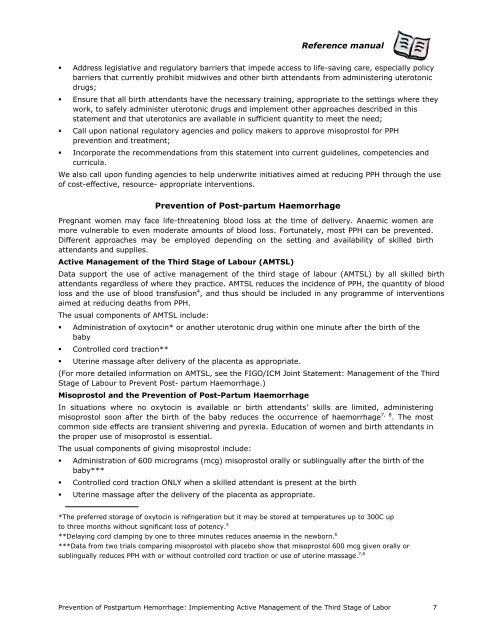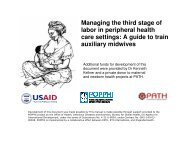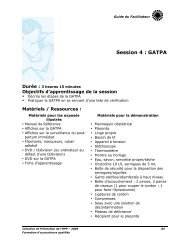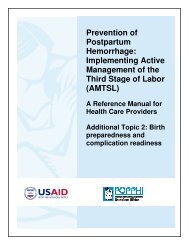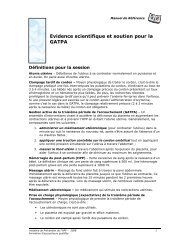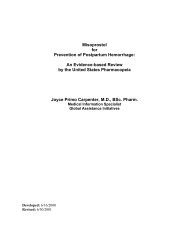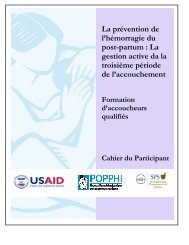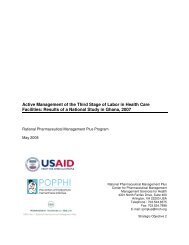Implementing Active Management of the Third Stage of Labor
Implementing Active Management of the Third Stage of Labor
Implementing Active Management of the Third Stage of Labor
You also want an ePaper? Increase the reach of your titles
YUMPU automatically turns print PDFs into web optimized ePapers that Google loves.
Reference manual<br />
<br />
<br />
<br />
<br />
Address legislative and regulatory barriers that impede access to life-saving care, especially policy<br />
barriers that currently prohibit midwives and o<strong>the</strong>r birth attendants from administering uterotonic<br />
drugs;<br />
Ensure that all birth attendants have <strong>the</strong> necessary training, appropriate to <strong>the</strong> settings where <strong>the</strong>y<br />
work, to safely administer uterotonic drugs and implement o<strong>the</strong>r approaches described in this<br />
statement and that uterotonics are available in sufficient quantity to meet <strong>the</strong> need;<br />
Call upon national regulatory agencies and policy makers to approve misoprostol for PPH<br />
prevention and treatment;<br />
Incorporate <strong>the</strong> recommendations from this statement into current guidelines, competencies and<br />
curricula.<br />
We also call upon funding agencies to help underwrite initiatives aimed at reducing PPH through <strong>the</strong> use<br />
<strong>of</strong> cost-effective, resource- appropriate interventions.<br />
Prevention <strong>of</strong> Post-partum Haemorrhage<br />
Pregnant women may face life-threatening blood loss at <strong>the</strong> time <strong>of</strong> delivery. Anaemic women are<br />
more vulnerable to even moderate amounts <strong>of</strong> blood loss. Fortunately, most PPH can be prevented.<br />
Different approaches may be employed depending on <strong>the</strong> setting and availability <strong>of</strong> skilled birth<br />
attendants and supplies.<br />
<strong>Active</strong> <strong>Management</strong> <strong>of</strong> <strong>the</strong> <strong>Third</strong> <strong>Stage</strong> <strong>of</strong> Labour (AMTSL)<br />
Data support <strong>the</strong> use <strong>of</strong> active management <strong>of</strong> <strong>the</strong> third stage <strong>of</strong> labour (AMTSL) by all skilled birth<br />
attendants regardless <strong>of</strong> where <strong>the</strong>y practice. AMTSL reduces <strong>the</strong> incidence <strong>of</strong> PPH, <strong>the</strong> quantity <strong>of</strong> blood<br />
loss and <strong>the</strong> use <strong>of</strong> blood transfusion 4 , and thus should be included in any programme <strong>of</strong> interventions<br />
aimed at reducing deaths from PPH.<br />
The usual components <strong>of</strong> AMTSL include:<br />
<br />
<br />
<br />
Administration <strong>of</strong> oxytocin* or ano<strong>the</strong>r uterotonic drug within one minute after <strong>the</strong> birth <strong>of</strong> <strong>the</strong><br />
baby<br />
Controlled cord traction**<br />
Uterine massage after delivery <strong>of</strong> <strong>the</strong> placenta as appropriate.<br />
(For more detailed information on AMTSL, see <strong>the</strong> FIGO/ICM Joint Statement: <strong>Management</strong> <strong>of</strong> <strong>the</strong> <strong>Third</strong><br />
<strong>Stage</strong> <strong>of</strong> Labour to Prevent Post- partum Haemorrhage.)<br />
Misoprostol and <strong>the</strong> Prevention <strong>of</strong> Post-Partum Haemorrhage<br />
In situations where no oxytocin is available or birth attendants’ skills are limited, administering<br />
misoprostol soon after <strong>the</strong> birth <strong>of</strong> <strong>the</strong> baby reduces <strong>the</strong> occurrence <strong>of</strong> haemorrhage 7, 8 . The most<br />
common side effects are transient shivering and pyrexia. Education <strong>of</strong> women and birth attendants in<br />
<strong>the</strong> proper use <strong>of</strong> misoprostol is essential.<br />
The usual components <strong>of</strong> giving misoprostol include:<br />
<br />
<br />
<br />
Administration <strong>of</strong> 600 micrograms (mcg) misoprostol orally or sublingually after <strong>the</strong> birth <strong>of</strong> <strong>the</strong><br />
baby***<br />
Controlled cord traction ONLY when a skilled attendant is present at <strong>the</strong> birth<br />
Uterine massage after <strong>the</strong> delivery <strong>of</strong> <strong>the</strong> placenta as appropriate.<br />
*The preferred storage <strong>of</strong> oxytocin is refrigeration but it may be stored at temperatures up to 300C up<br />
to three months without significant loss <strong>of</strong> potency. 5<br />
**Delaying cord clamping by one to three minutes reduces anaemia in <strong>the</strong> newborn. 6<br />
***Data from two trials comparing misoprostol with placebo show that misoprostol 600 mcg given orally or<br />
sublingually reduces PPH with or without controlled cord traction or use <strong>of</strong> uterine massage. 7,8<br />
Prevention <strong>of</strong> Postpartum Hemorrhage: <strong>Implementing</strong> <strong>Active</strong> <strong>Management</strong> <strong>of</strong> <strong>the</strong> <strong>Third</strong> <strong>Stage</strong> <strong>of</strong> <strong>Labor</strong> 7


